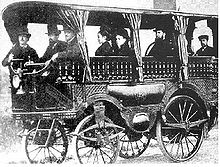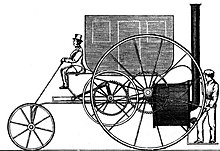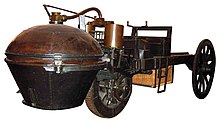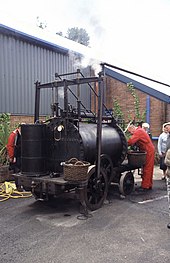Steam car
![]()
Dampfkraftwagen is a redirect to this article. For the former German automobile and motorcycle brand Dampf-Kraft-Wagen see DKW
![]()
This article deals with automobiles powered by steam. For railway vehicles previously mentioned in the same way, see steam locomotive and steam railcar.
A steam-powered vehicle, or steam car for short, is a motor vehicle that is driven by a steam generator (usually a steam boiler) by means of a steam engine, steam motor or steam turbine (heat engine with external combustion as opposed to an internal combustion engine). Cheap fuels such as firewood, coal, coke or tar oil can be used as fuel for steam generation.
Steam-powered cars were the very first motor vehicles: Nicholas Cugnot made a start as early as 1769 with an artillery traction engine (French: Fardier = freight tractor). The La Mancelle, developed by Amédée Bollée in 1878, was the first steam-powered automobile to be built in series, with 50 examples (a good 10 years before Carl Benz presented his Benz Patent Motor Car No. 3 to a wide audience at the 1889 World's Fair in Paris). In 1906, Fred Marriott set a world speed record for steam-powered automobiles of 205.5 km/h on the Daytona Beach Road Course with the Model Stanley Rocket Steamer.
Until around 1920, steam propulsion competed with petrol engines and electric cars (e.g. La Jamais Contente was the first car to travel at over 100 km/h), until the internal combustion engine finally prevailed with technical improvements and a growing network of filling stations. Steam-powered buses were used as commercial vehicles for a long time, and steam-powered trucks, tractors and road rollers were still used in isolated cases until the 1950s.

L'Obéissante by Amédée Bollée (recording 1875)
_pic2.JPG)
Jacquot Steam Carriage, 1878

First commercial steam carriage London Steam Carriage by Richard Trevithick, 1803
Delimitation
This article describes steam cars, i.e. automobiles and commercial vehicles with steam propulsion, which were built for the transport of passengers or goods, in contrast to steam traction engines, steam tractors, steam rollers and other construction machines. Locomobiles, also called portable engines or portables for short, on the other hand, are merely steam engines that can be towed to changing locations with their chassis, usually without self-propulsion, i.e. not motor vehicles.

Steam tractor Lena from Wallis & Steevens, year of construction 1905
Early developments
Beginning in the 17th century in China
In the 17th century, the first operable model of a steam car was built and described by Ferdinand Verbiest in China, but without illustration. See also History of the Automobile.
Fardier by Nicholas Cugnot (1769)
A steam carriage was first introduced to the European public by Nicholas Cugnot in Paris in 1769. Before that, carriages were moved by people or animals, or rarely, by the wind. The steam engine built into the Fardier was the same as that built by the Russian Ivan Ivanovich Polsunov in 1763, and it was probably through publications in the Siberian Letters of the explorer Laxmann that information flowed to France. However, the Fardier was not successful from the beginning, because the vehicle drove into the surrounding wall of the military barracks during a demonstration before high military officials and broke through it; Cugnot had forgotten to equip the steam carriage with brakes.
The original Fardier was initially kept in the Arsenal and has been in the Musée des arts et métiers in Paris since 1800. A working replica belongs to the DB Museum in Nuremberg and is on display there after being on loan to the Tampa Bay Automobile Museum in the USA from 2005 to 2011.
Richard Trevithick's models from 1797, 1801, 1803
The British inventor, engineer and mechanical engineer Richard Trevithick built his first steam car model in 1797. The boiler was heated by means of a glowing cast iron rod inserted into the flame tube instead of the real furnace. In 1801 he exhibited at Camborne one of his new small steam engines on wheels. This "road locomotive", known as the Puffing Devil, carried passengers at a speed of 8 km/h even over inclines.
After building the world's first railway steam locomotive in 1802, he constructed another self-propelled vehicle in 1803, the London Steam Carriage, which was basically a stagecoach equipped with a steam engine. It attracted the attention of the public and the press, but was much more expensive to run than an ordinary horse-drawn carriage and therefore failed to catch on.
Ground drives with stilts and push rods
At the beginning of the 19th century, lively research activity began in order to get to grips with the fundamental problems of automobiles powered by steam. In 1811, the British engineer William Brunton (1777-1852) patented a drive for steam-powered cars that was based on the front legs of horses. A wheeled steam engine drove this stilt-like linkage and achieved walking speed with the equivalent of two horsepower. "Brunton's mechanical traveller" did not get beyond the prototype stage; the steam boiler exploded, killing several spectators.
In December 1824, Scottish inventor David Gordon (1774-1829) filed a patent that would use push rods to realize the locomotion of the "Steam Carriage" even on inclines. The Times described the problem in 1825 thus:
"A great trouble is caused by the wheels, which slip on the road without making any progress, as soon as the slightest incline or a heavy load makes the friction on the axle greater than that between the edge of the wheels and the ground; all the power of the machine is then used only for spinning the wheels, without the car making an inch of progress."
The minibuses that Gordon and his competitor Gurney built at almost the same time were driven by several push rods connected by axles to the steam engine. To accelerate, the driver lowered the rod tips downward; when going downhill, he raised the structure. Gordon's car, unlike Gurney's, had front-wheel drive. Six push rods were in use. For easier steering, the automobile featured only one wheel in front. The passengers sat in a row, one behind the other.

Fardier by Nicholas Cugnot, 1769

Road locomotive Puffing Devil by Richard Trevithick, 1801 (replica)
Search within the encyclopedia